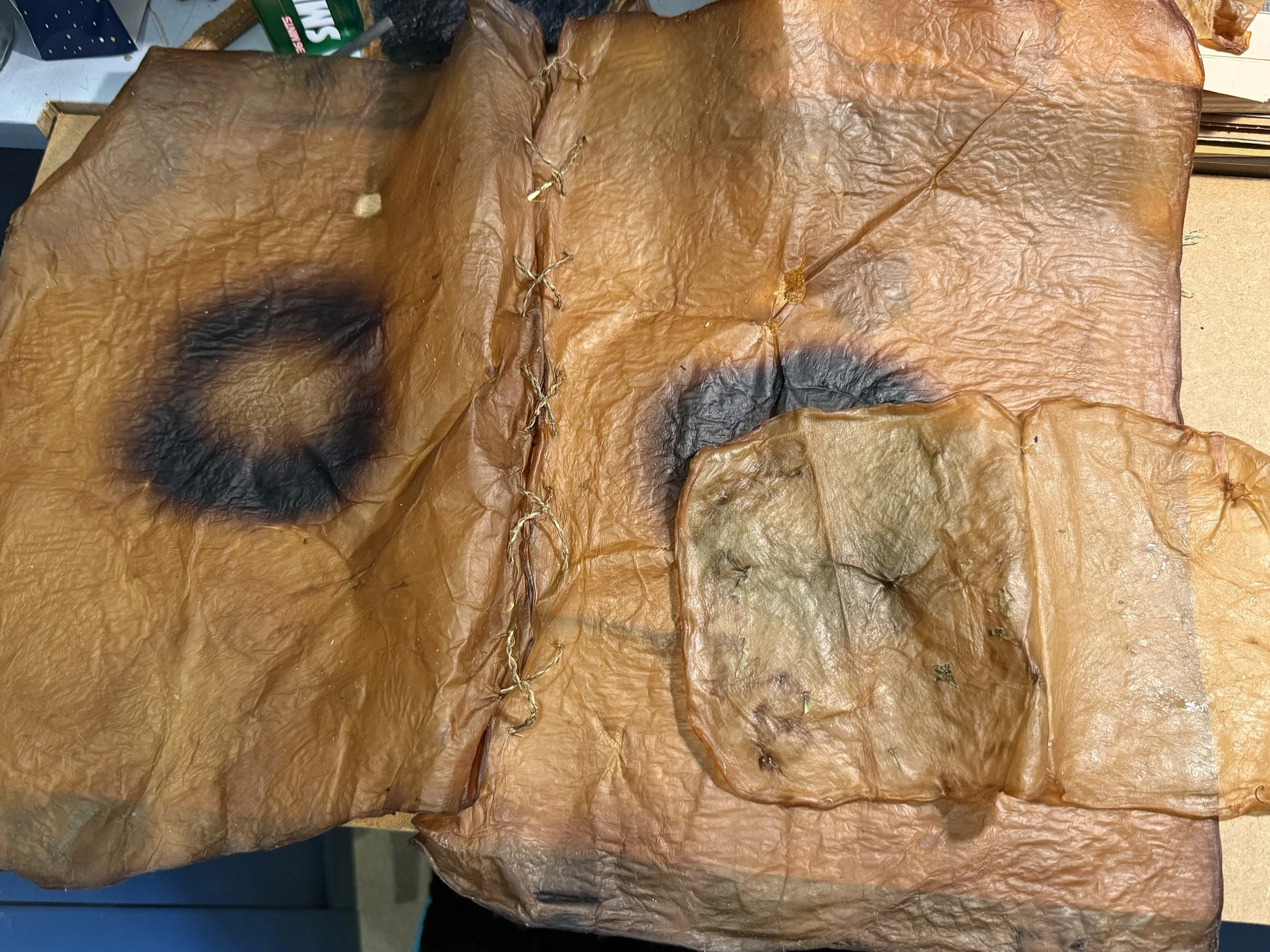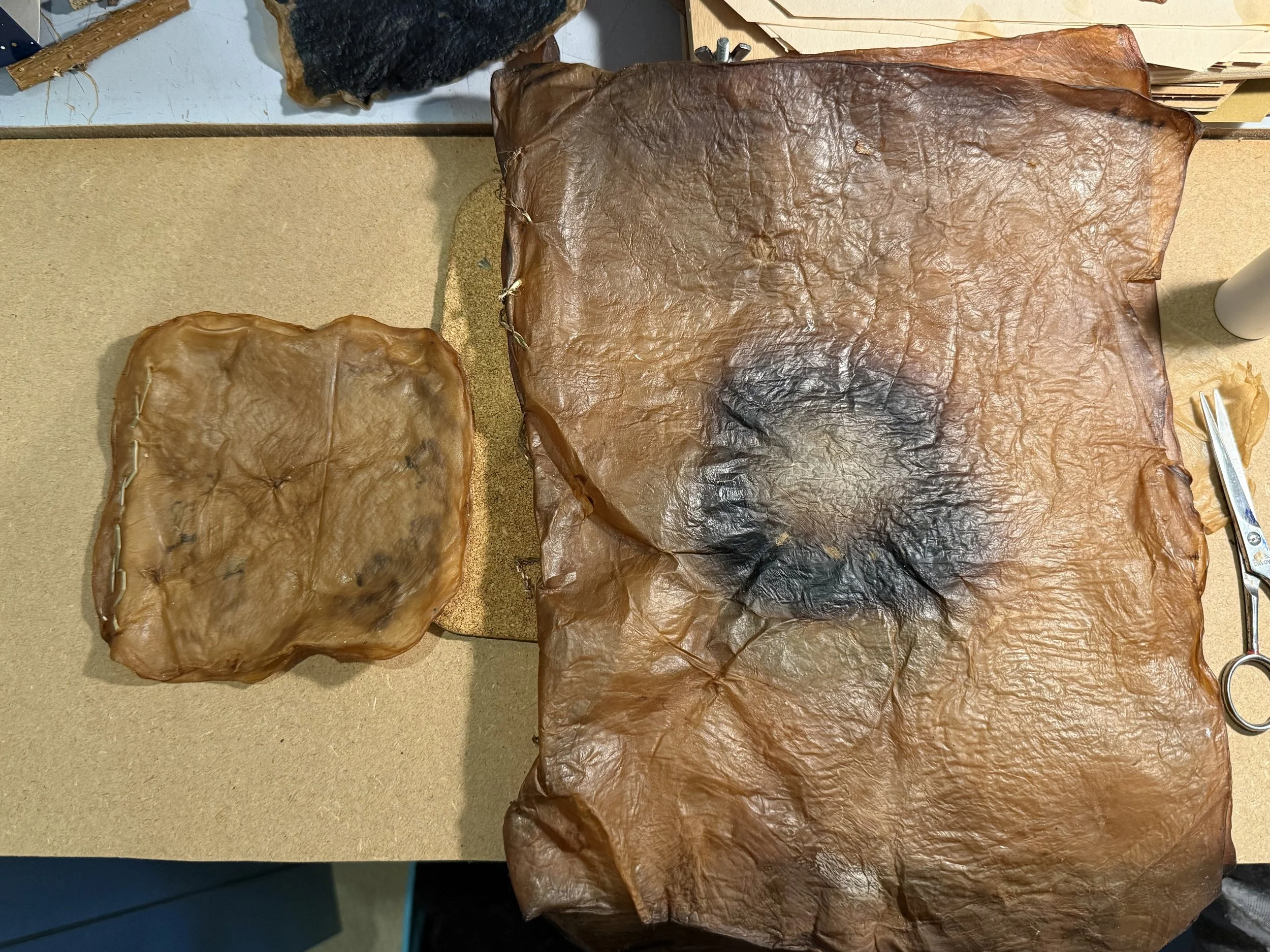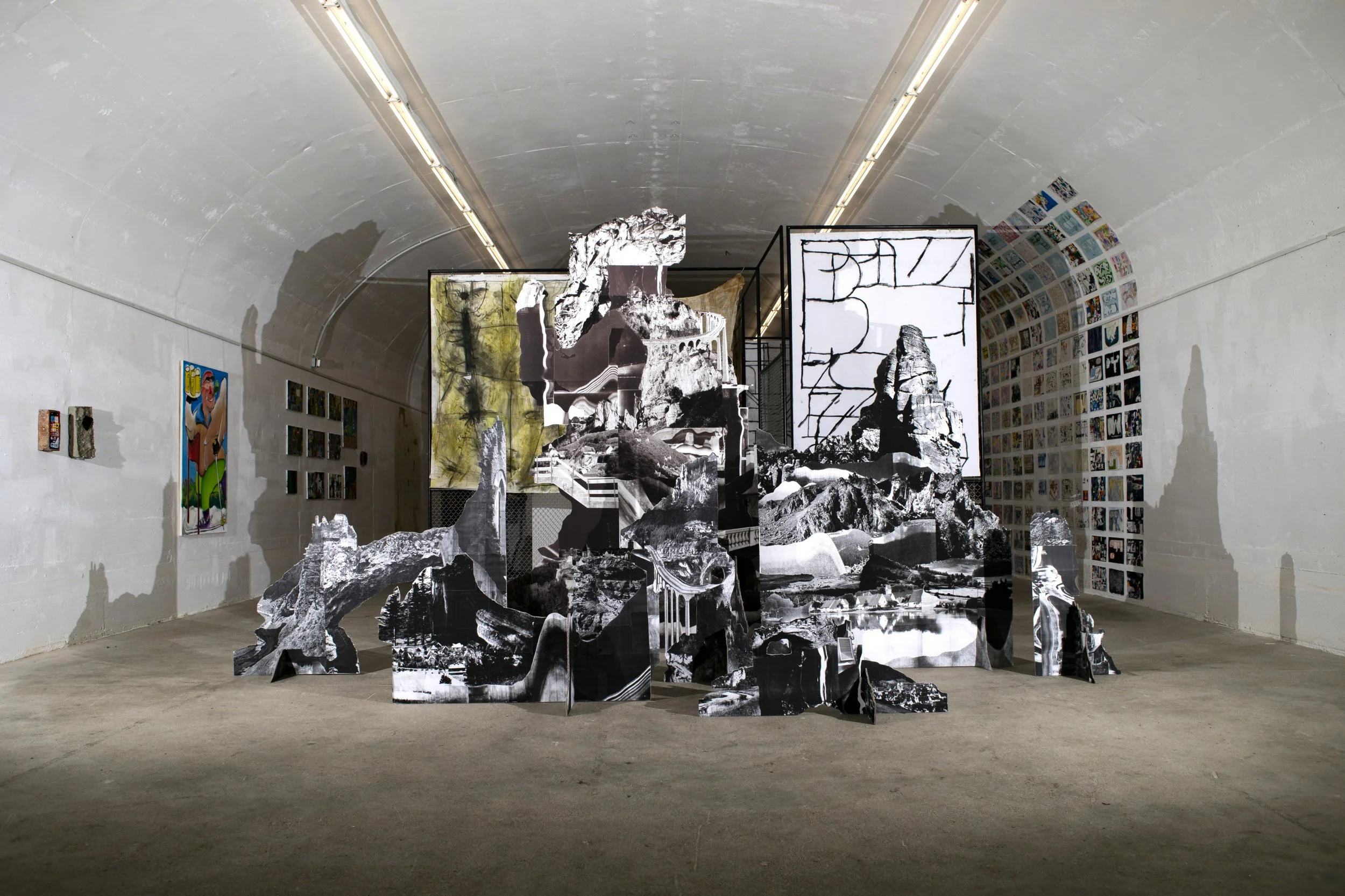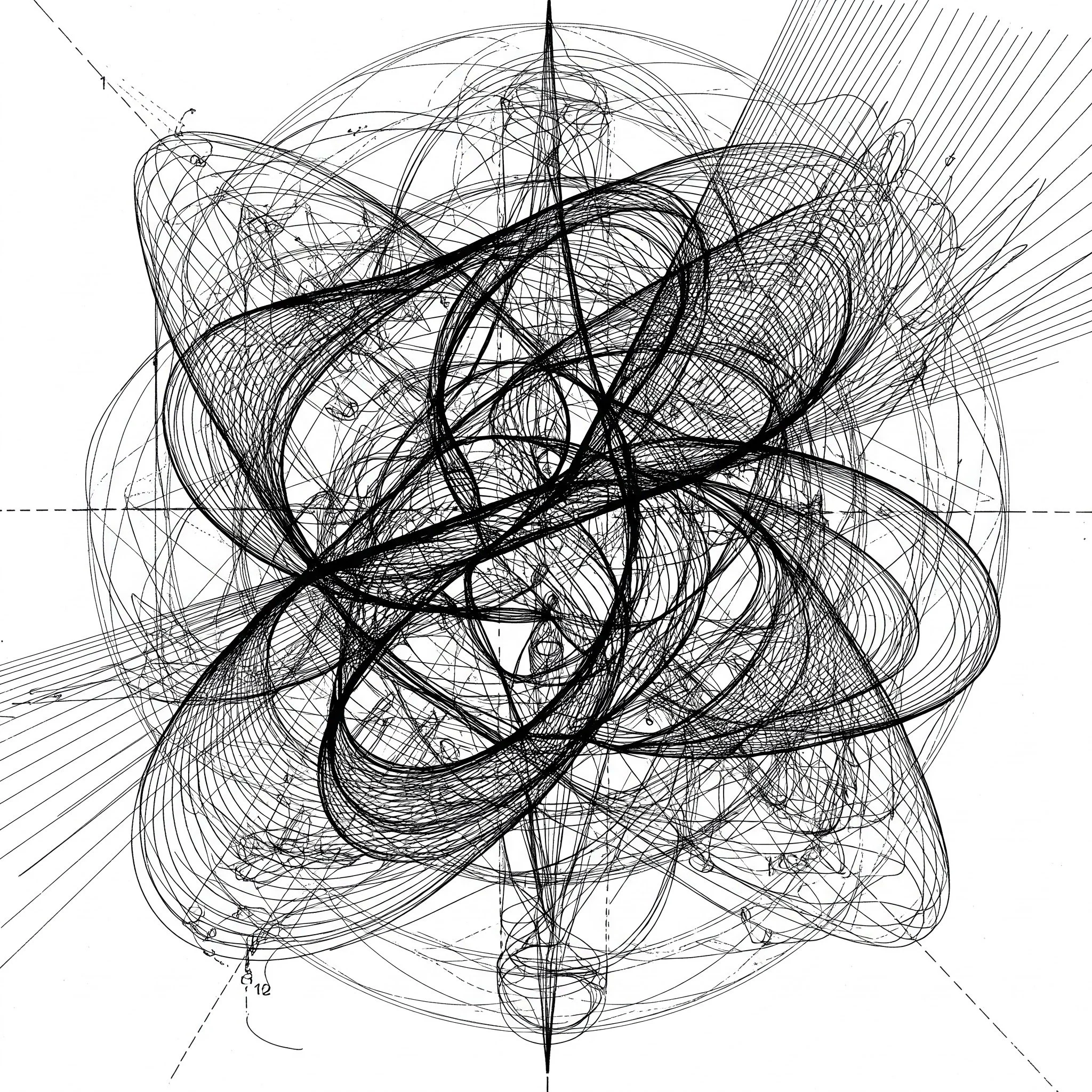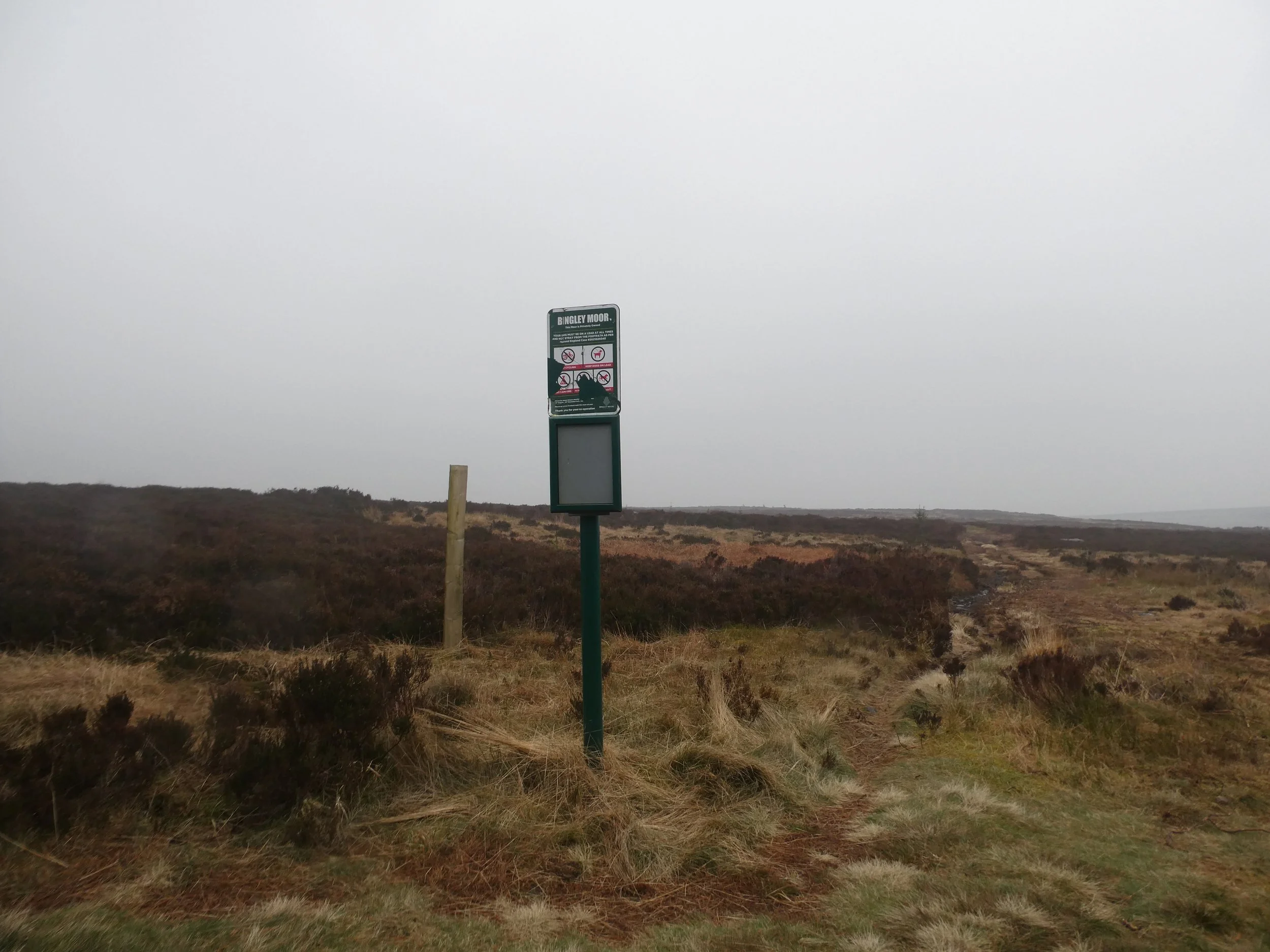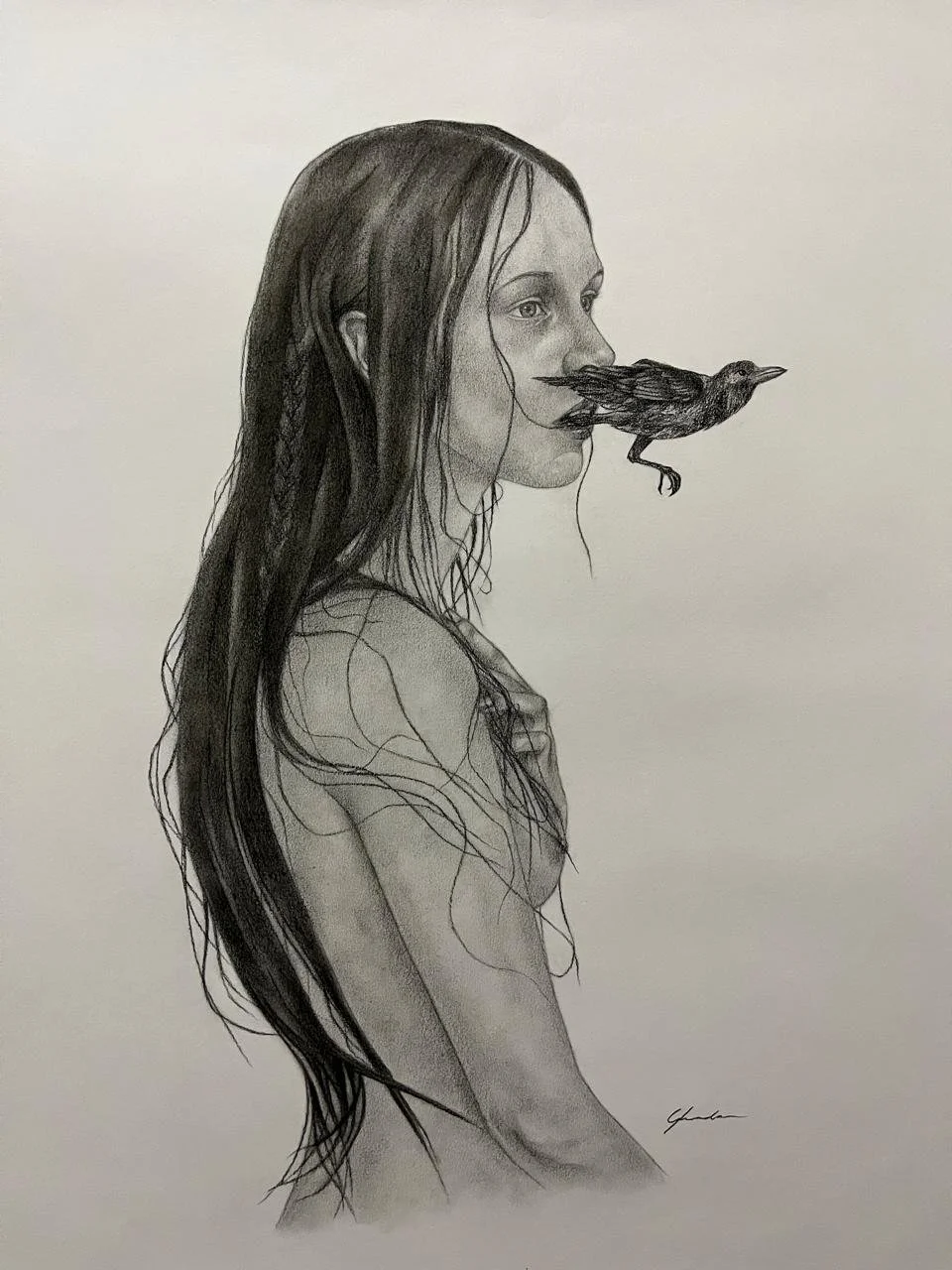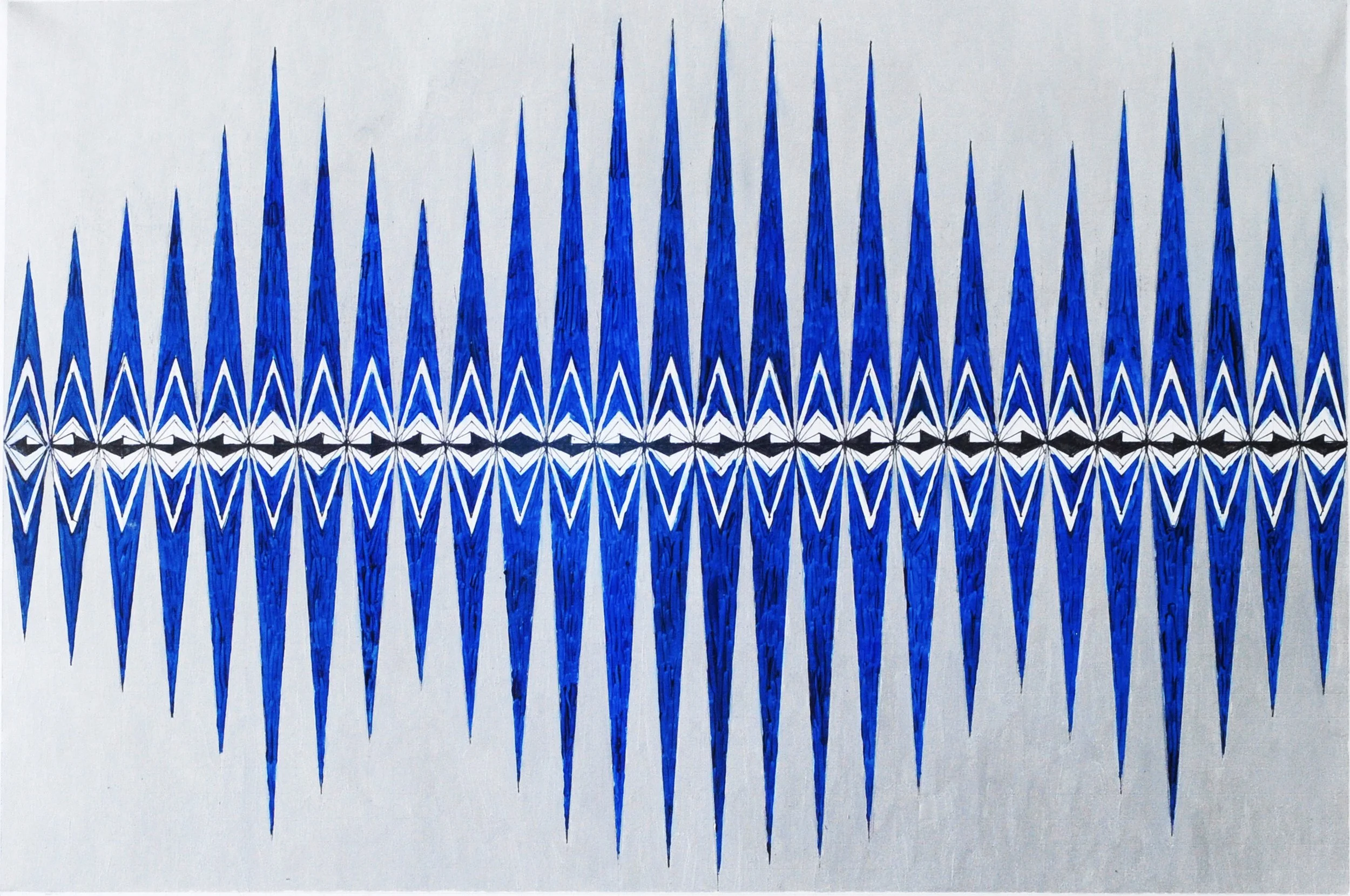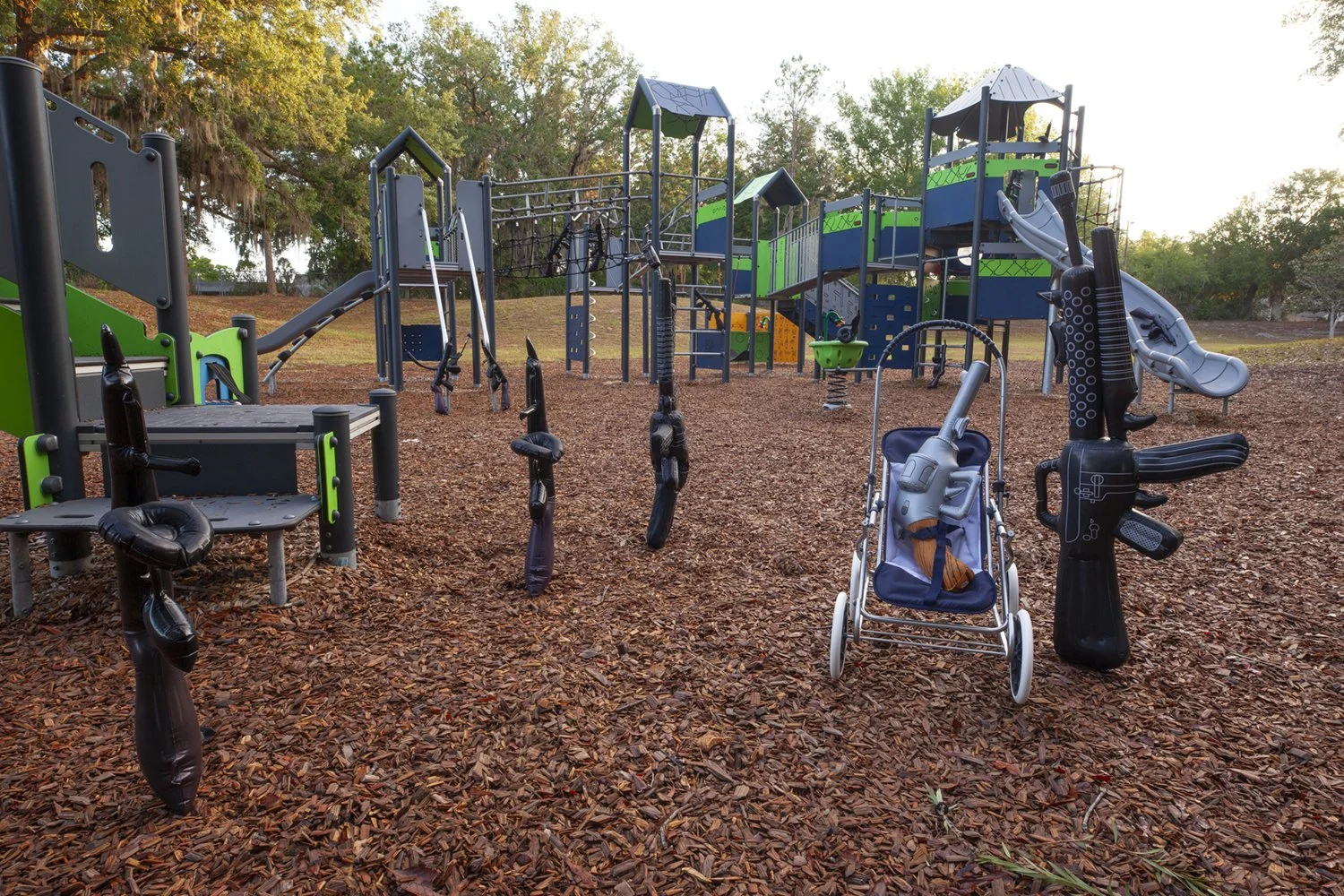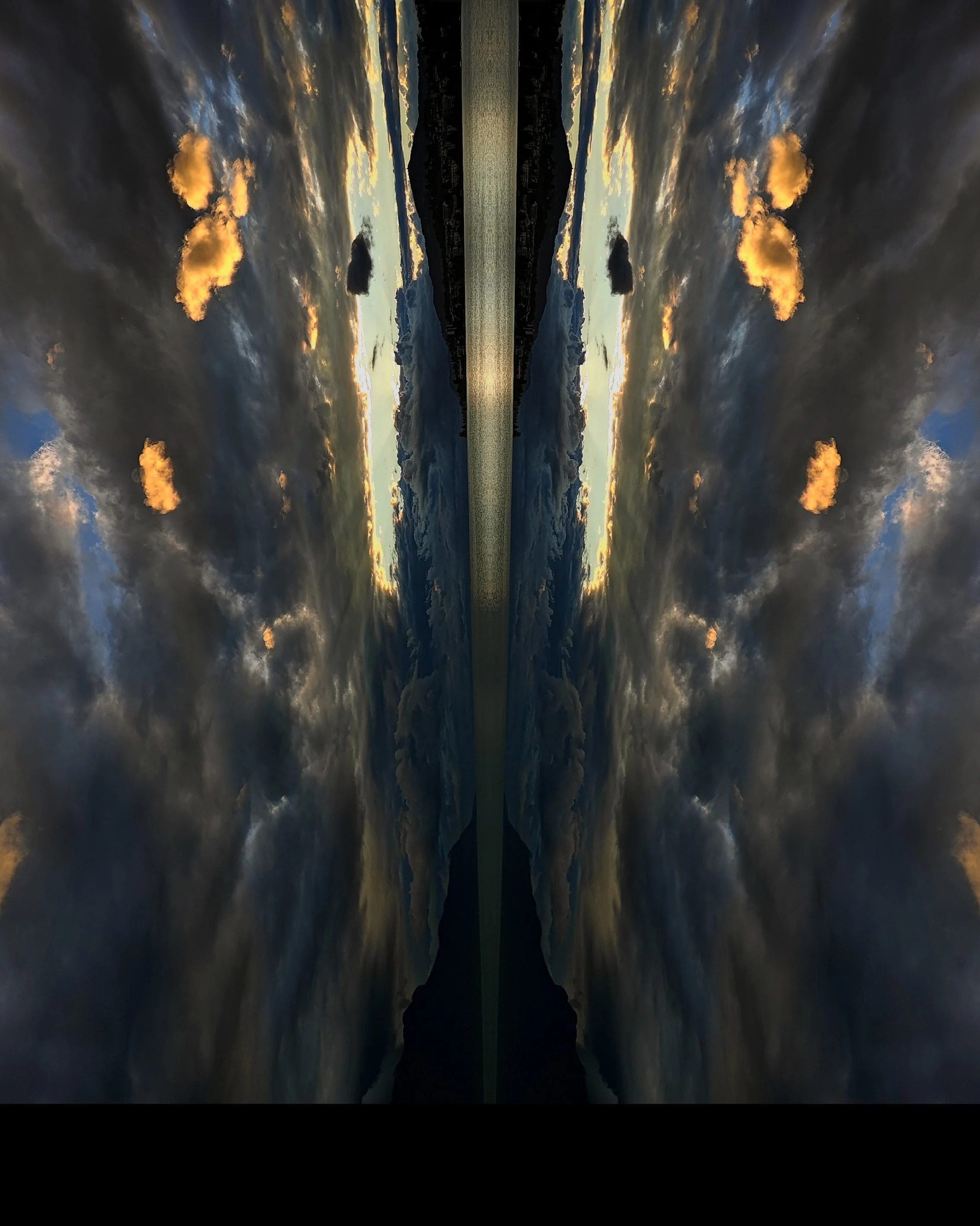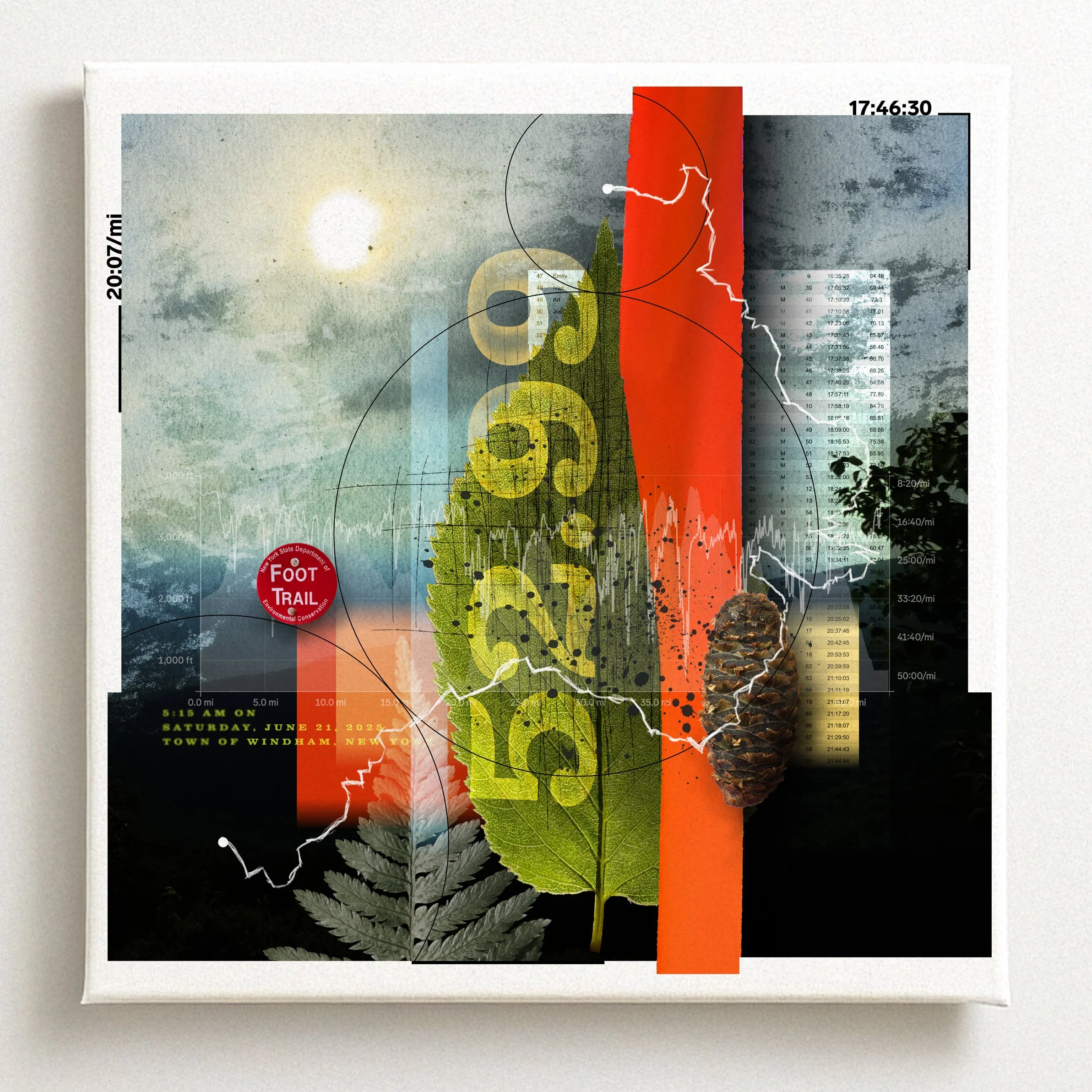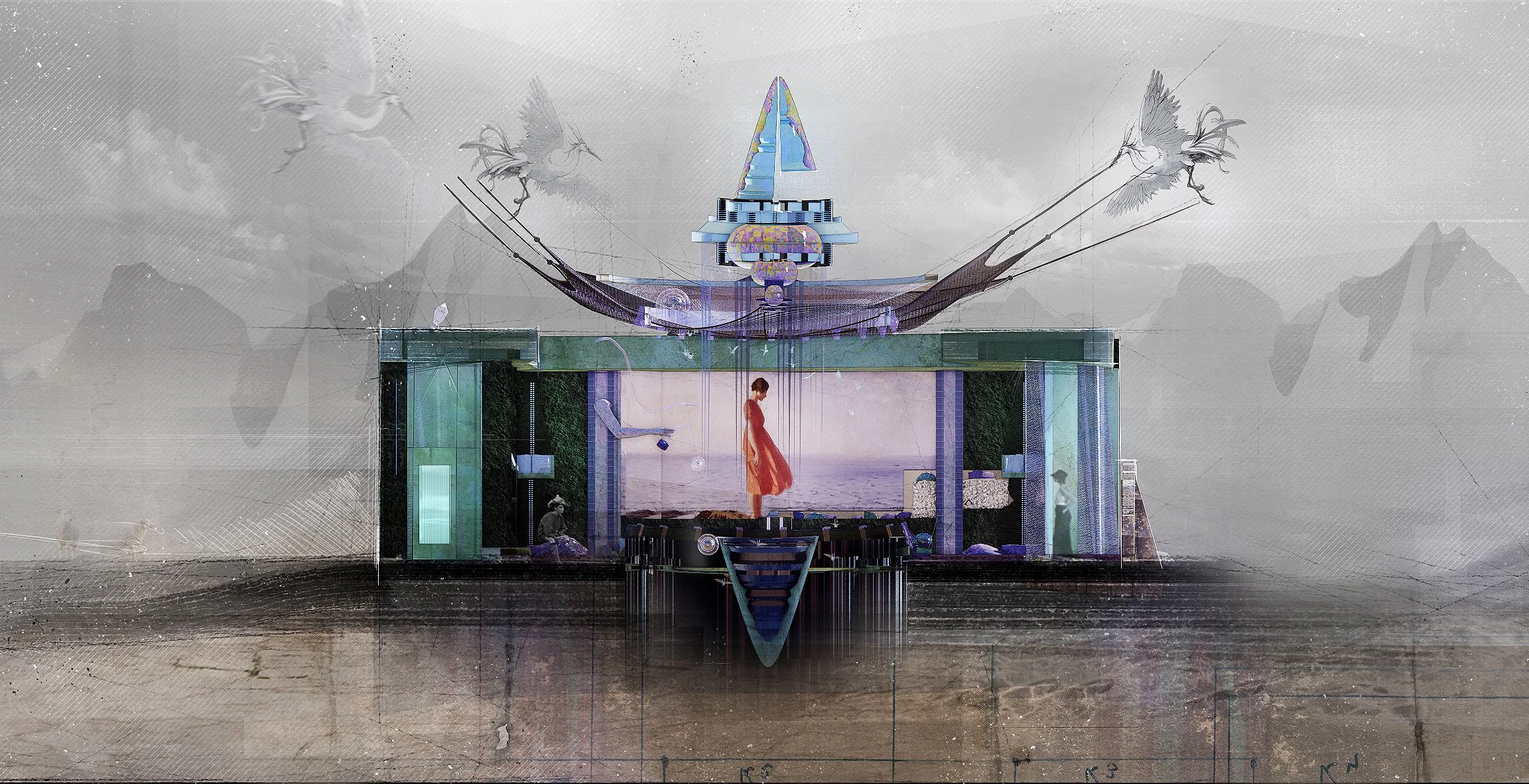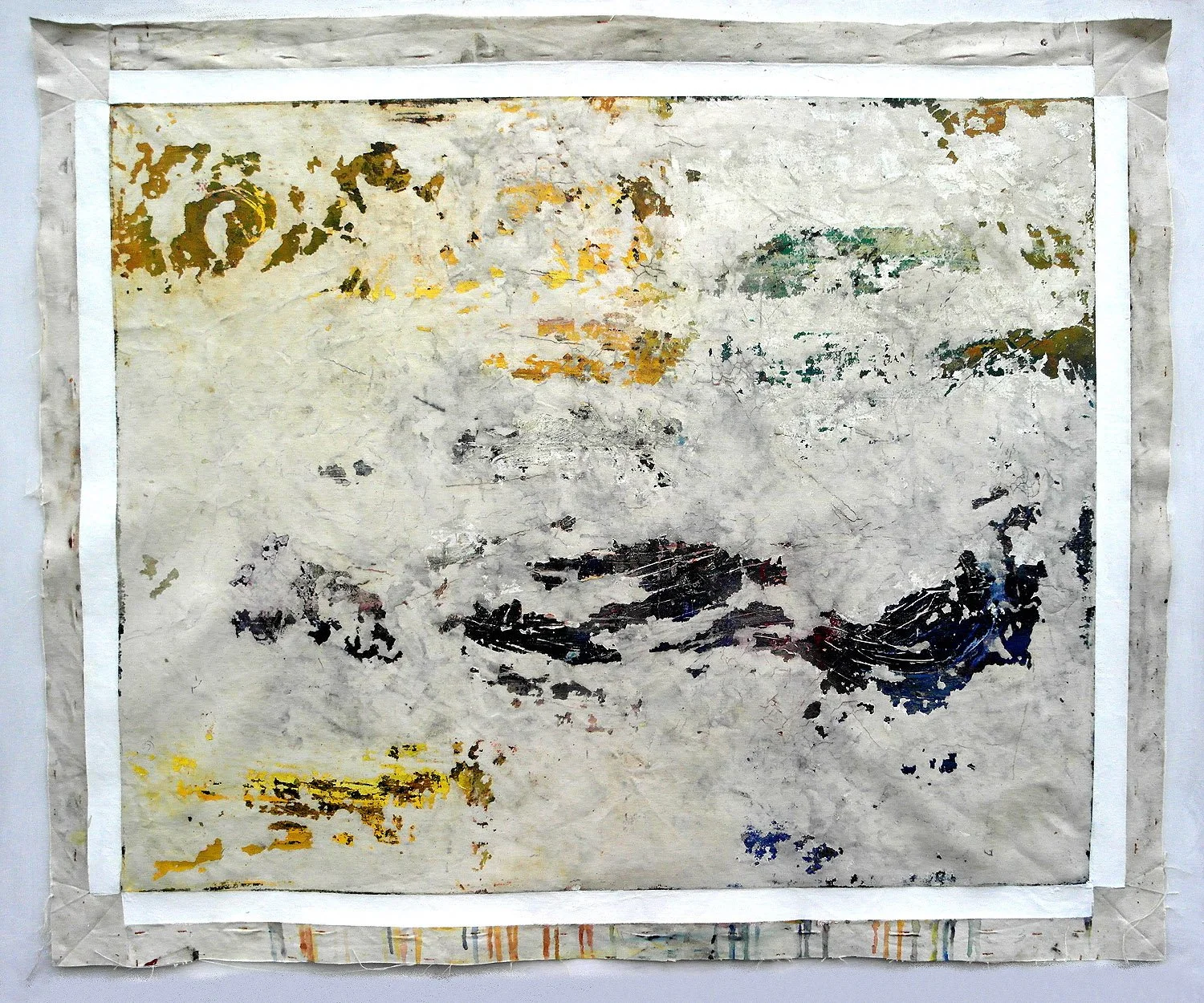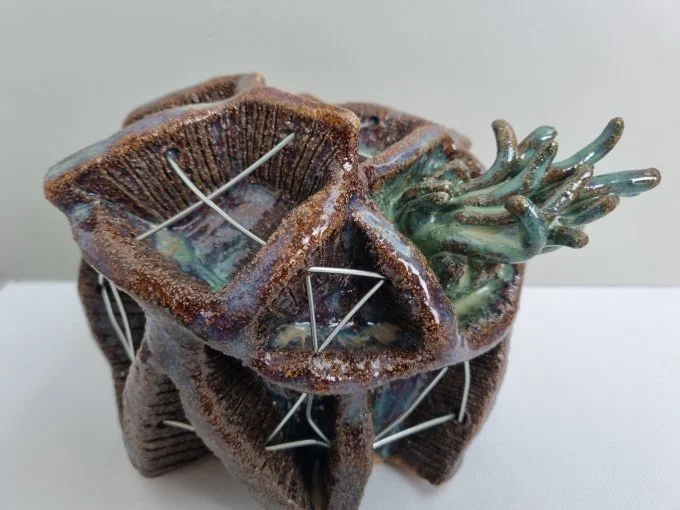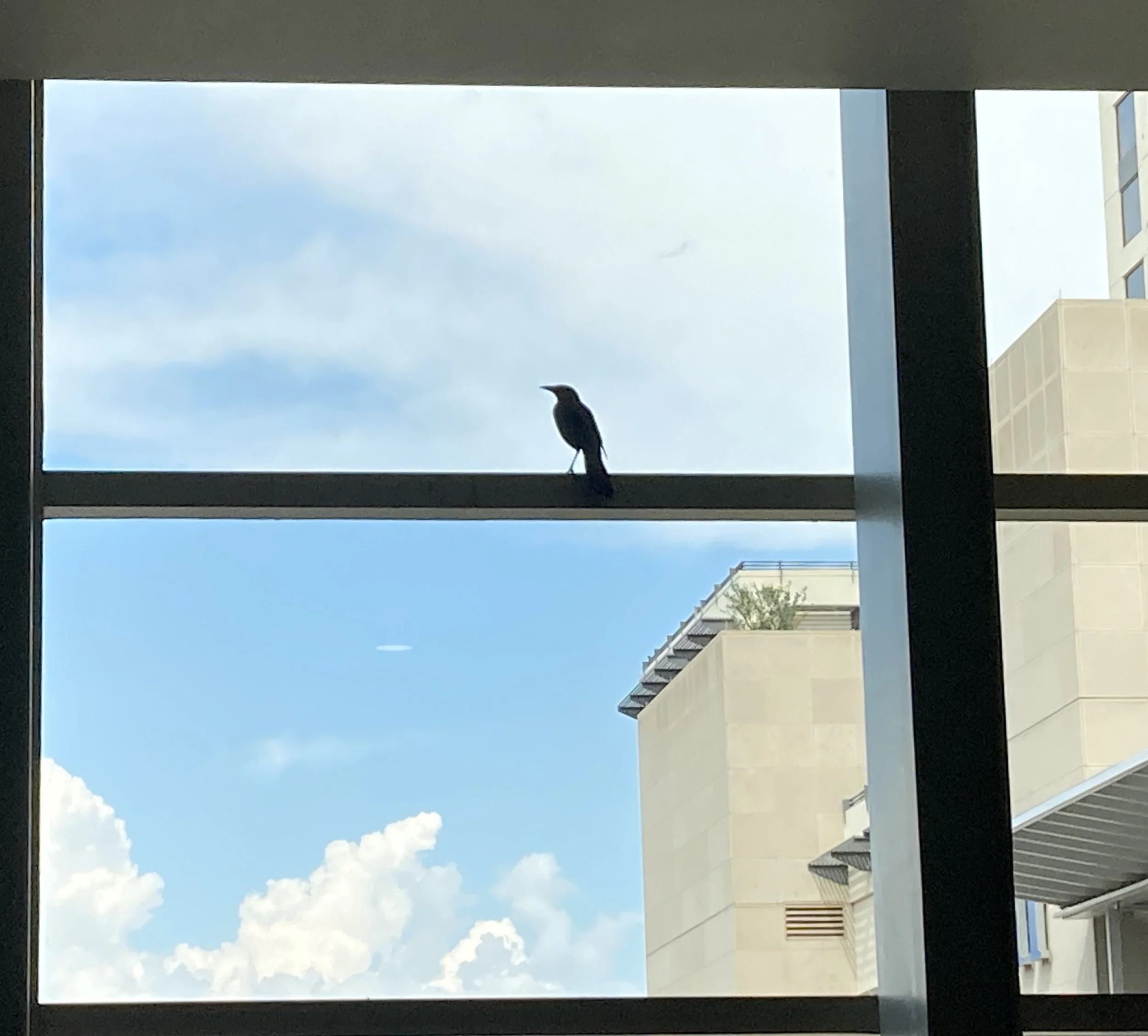BOUNDARIES can take many forms.
They state where one thing ends and another begins. They act as separators and define a border.
They can be implicit or clearly defined. They can be legal, part of a code of conduct, expected, geographical, emotional, conceptual and political.
They can change over time and evolve.
Sara Ahmed writes in "Strange Encounters" about the many types of borders, which include skin, neighbourhoods, culture, fear, and belief systems.
There are some borders we can control and others we cannot.
For this open call, we sought art and writing that explored how we can push against borders in all their forms.
Artist: Lucy Denton
Look.
Description: A creative piece of mark-making that I'd like to represent and add other aspects of barriers people have to fight and get in the way of potential. Reflects the current feeling of trying to find work.
Artist - Nichola Rodgers
Description: This artwork explores the innovative potential of kombucha SCOBYs, pushing the boundaries of material practice through sustainable, living processes. By cultivating the SCOBYs in shaped molds, I harness their organic growth to create uniquely formed sheets, which are then dried, twisted into twine, and reimagined as tactile, sculptural fibers. This transformation allows for weaving, stitching, and binding in collaboration with nettle twine, another ancient, sustainable material. The resulting work challenges conventional notions of paper, textile, and bookmaking, blurring the lines between living organism and crafted artefact. The kombucha "paper" book becomes both an object and an ecosystem: a reflection on temporality, resilience, and the material intelligence of nature. Through this evolving practice, I aim to question what materials can be, where they come from, and how we engage with them in a world shifting toward regenerative, post-industrial approaches to art and design. It is both ritual and research.
Artist: Marc Allgaier
www.marcallgaier
Berg- und Talfahrt
Description: Spatial collage, mixed media installation (cardboard, photographic fragments, architectural elements) Berg- und Talfahrt is an immersive spatial installation that challenges visual conventions and spatial hierarchies. Constructed from layered cardboard, photographic cuttings, and architectural forms, it unfolds as a walkable landscape — a fragile structure between ruin and rhythm, erosion and invention. The work operates at the boundary between image and space. Neither fully sculpture nor fully collage, it questions the role of representation in environments that are unstable, fragmented, or in flux. By layering materials that are themselves transient and often overlooked, the piece invites viewers to physically enter a space of uncertainty — one where orientation becomes part of the experience. Berg- und Talfahrt pushes boundaries not only through material use, but through its conceptual openness. It resists fixed narratives and instead offers a matrix of traces: architectural echoes, visual ruptures, and sedimented memories. Every step through the installation becomes an act of negotiation — with gravity, with surface, with one’s own sense of stability. Rather than depicting a known reality, the work creates a poetic structure that gestures toward transformation — personal, political, perceptual. Its instability is its language; its lack of conclusion is its invitation. In this sense, Berg- und Talfahrt doesn't illustrate the theme of boundary-breaking — it enacts it…
Artist: MACHAC
https://machac.art
POLITIC-IA.
Description: AI GENERATED with Google Gemini 2,5 pro. My work revolves around a desire to demystify the "black box" of art generation through Artificial Intelligence (AI), offering a tangible and visual interpretation of its intention. My instructions to the AI are not precise commands to produce a specific image, but rather explorations of concepts. I blur the boundaries of creative intention. My true purpose is not to direct AI toward a specific goal, but rather to reveal what emerges from its own internal processes.
Artist: Paul Tranter
https://paul-tranter.com/
This moor is privately owned
Description. Who has the right to own wild places? We can roam across the moors, high up in England’s northern lands, but at each twist and turn of the track or trail, signposts, like the one captured in this digital photograph, and which wouldn’t look out of place on an urban high street, tell us: ‘Lucky you. We’ll give you access, but whatever you do, don’t do any of the things on this list’. But these complex networks of ownership go back many hundreds of years. The landscape they have carved up far from natural, intensely managed for sport or timber, but not always for nature or for the amenity value or the joy, happiness and wellbeing that people accessing this land can gain. Do we rail against that, or simply accept the status quo and thank our lucky stars we can still roam these wild places.
Artist: Becca Sebire
Flying between
Description: ‘Flying between’ is a combined installation of mural and window frames constructed out of wood. The work is centred on the themes of migration between Latin and North America. Depicting the contrasting landscapes of these two places, as well as the interiors that are stereotypical to them, this mural is a vivacious exploration of colour and beauty of the landscapes. An explicit borderline runs down the centre of the piece, separating the two places with migrant birds that have now established populations in the USA. Inspired by ‘proposal for a parakeets garden’ from Adham Faramawy, I wanted to use birds to symbolise people who have emigrated to suggest a freedom of movement that is a fundamental right for both people and animals. The interiors viewed from the window frame are a contrast of perspective norm when placed in the centre of the landscapes – suggesting a new way of viewing home. Website – beccasebireart.wordpress.com
Artist: Ghada Ben Hassan
https://ghadabenhassan.mystrikingly.com/
Departure
Description: Departure explores the invisible boundaries between past and present, grief and release. Just like the way a bird has to eventually leave the nest, some things need to depart us. Some departures are physical, others deeply internal: a fading dream, a persistent longing, a sorrow too dense to name. This piece reflects on how emotional experiences often cross into the body, manifesting as tension, discomfort, or pain. These are the quiet, unspoken border between what is felt and what is shown, between internal suffering and external silence. In Departure, I attempt to give form to that space where pain becomes visible, where the intangible becomes touchable. By facing these hidden boundaries within ourselves, we allow what burdens us to be transformed, not erased, but freed. Departure, then, is not an ending, but the crossing of a boundary that was never meant to contain us forever.
Artist: Karen Piddington
https://www.karenpiddington.co.uk/
Sheep Gaze.
Description: Experimental Film (duration 6 mins) Sheep Gaze delves into the dissolution of boundaries between human and nonhuman realms, presenting a visceral confrontation with the unfamiliar. Drawing inspiration from a chance encounter with a sheep whose confident gaze defied expectation, the film magnifies and distorts the animal’s features using a fisheye lens. This transformation blurs the sheep’s identity to the point where it evokes entirely different creatures, such as a polar bear, and suggests a fluid and shifting identity that defies categorisation. The film challenges traditional dynamics of observation. By positioning the sheep’s unwavering gaze as the focal point, the work dismantles the human-centred “conquering gaze” described by Donna Haraway, which assumes an objective yet dominantly human perspective. Instead, the sheep’s gaze asserts its agency, sensations, desires and secrets, forcing the viewer to reckon with their position as the observed rather than the observer. This inversion disrupts the illusion of human dominance, inviting the audience into an embodied encounter where the nonhuman subject becomes an active participant, pushing boundaries. Sheep Gaze confronts conceptual and perceptual boundaries, questioning how humans perceive and relate to other beings. It pushes against the boundaries of identity, challenging the viewer to consider the fluidity of nonhuman perspectives. The direct, amplified gaze of the sheep invites us to question the assumptions that underpin human observation, revealing that boundaries-be—be they physical, conceptual, or emotional—are more permeable than they seem.
Artist: Danielle Grace Oliver
@danielle.g.oliver www.danielleoliver.art
Loud Minds, Fragile voices.
Description: Danielle Oliver, 2025 Mixed media: photography, physical collage, digital manipulation, typography Hardcut Form. This work is an interpretation of themes identified during The Unmute Project workshops using my Hardcut Form methodology. Typography is not decoration in my practice. It is the primary medium. Every structural decision in this piece was made to reflect the gap between thought and voice. The participants spoke about what it means to hold back. Not because they had nothing to say, but because experience had taught them not to say it. Many described anxiety, low self-esteem, and the weight of trying to stay composed while being dismissed or misunderstood. Several were neurodivergent and spoke about the mental effort required just to form a sentence in spaces that don’t accommodate them. I built the image using a planned photoshoot and three physical collages, each constructed for tonal contrast and surface weight. The materials were chosen for disruption, not aesthetics. They were blended manually into four colour channels, including a fourth texture that binds the composition. The red, fragile tape across the mouth was part of the original structure. The collage around it holds the noise. The typography doesn’t explain. It sits inside the tension. I heard them. That’s why this exists. Some were already worn out by the time they spoke.
Artist: Zivia Li
Website: https://zivia-lyz.cargo.site/
The Smart Mirror: An Interface of Data and Identity (Video name:A Portrait in Data)
Description
This project investigates how data, as an interface, actively shapes identity through direct and dynamic interaction. Drawing on Karen Barad’s agential realism, it challenges the boundary between self-perception and algorithmic influence, proposing that identity is not fixed but continuously regenerated through intra-action with data. At its core is a multi-sensory installation comprising a custom-built smart mirror, an infrared proximity sensor, and a generative visual algorithm. When a viewer approaches or hovers a hand within range, the rolling geometric patterns halt, and a new identity ID is generated in real time. Each output—composed of dynamic line-based visuals and an alphanumeric identity code—is ephemeral, unique, and open to interpretation, prompting reflection on how external systems assign, mediate, and reshape identity. The project also includes a conceptual video, combining programmatically generated visuals, a code-based electronic soundtrack, and a spoken monologue. Rather than explaining the system, the video offers a parallel meditation on the philosophical implications of identity in a data-driven society. By fusing algorithmic aesthetics, embodied interaction, and philosophical reflection, the project pushes the boundaries between human agency and machine-driven identity formation. It invites viewers to confront how personal subjectivity is continuously entangled with—and increasingly shaped by—data systems, questioning the possibility of autonomy and self-determination in an era of algorithmic governance.
Artist: Angel Greenham
www.angelgreenham.co.uk
Beyond Earth 05.
Description: Oil on paper. 56 x 38 cm. Rooted in scientific data, her work distils visual language to its essence, embracing reduction and clarity as a means of exploring the liminal. In the Beyond Earth series, Angel engages with infrasound frequencies—sonic waves beyond human perception—captured in the stratosphere (the space above the Earth). Translating these ephemeral vibrations into visual form, she materialises the unseen, creating a threshold where the tangible meets the intangible.
Artist: Philip Ringler
https://www.philipringler.com/
My Family: Day At The Park
Description: My Family pushes the boundaries of photographic art by using inflatable machine guns to critically examine America’s entrenched gun culture. This conceptual series transforms objects of violence into soft, toy-like props, inviting a disarming yet unsettling response. By parodying the visual language of firearms, the work challenges viewers to confront the absurdity, normalisation, and fetishisation of guns in everyday American life, particularly in Florida. Humour and contradiction are central to the project. The inflatables are at once menacing and harmless, real and fake. This tension probes the blurred lines between representation and reality, echoing themes of simulacra and performativity. The title My Family references aggressive bumper stickers that depict guns as familial icons. I reinterpret this imagery to critique how violence and identity are often entwined in cultural narratives. Through satirical imagery and symbolic subversion, My Family explores how art can confront difficult truths and reshape public discourse. By repurposing signs of violence into tools of reflection, the series redefines what photography can do, turning visual spectacle into critical dialogue and pushing conceptual boundaries to expose the disturbing theatrics of American gun ideology.
Artist: Jane Hoodless
http://www.janehoodless.com
GRASS ROUTES
Description: Reminiscent of threadbare tapestries that were traditionally hung on walls or covered floors, GRASS ROUTES is one in a series of large-scale textile hangings inspired by the borders and boundaries imposed on us in public places. It is constructed from multiple images that show the physical restrictions we regularly contend with in public parks and gardens. Brick walls, flowerbeds, paths and fences have been digitally cropped, rotated, repeated and mirrored to transform actual boundaries into stylised decorative borders. Based on traditional geometric designs and using repetitive motifs that are both structural and metaphorical, the work has been deliberately distressed. [mono transfer-prints & sealer on unframed canvas: 105 x 140cm].
Artist: Max PhV
Vertical Sunset.
Description: Project Title: Pushing the Frame: Psychodynamic Photography in Urban Skies As a digital artist working with psychodynamic photography, I explore the boundary between perception and projection — between what the eye captures and what the psyche imposes. These mirrored images are made from everyday photos of sky, architecture, and movement, digitally manipulated using only native mobile tools. The result is a re-encoding of landscape and structure into emotionally charged, surreal visions that blur inner and outer worlds. Each of the works submitted questions about visual and psychological boundaries: What is real? What is reflected? What do we subconsciously recognise or resist in these abstracted environments? I aim to use urban and natural settings to provoke reflection on internalised limits — personal, spatial, and conceptual — and to invite viewers into landscapes that defy logical containment. This submission responds directly to the open call’s theme: pushing not only the visual limits of photography, but also the psychological boundaries of how space and identity are constructed. Artwork description Vertical Sunset, inkjet print on photographic paper, 78 x 99 cm, 2024 A symmetrical sunset folds the horizon upward, transforming a familiar natural scene into a portal-like structure. This piece challenges gravitational logic and draws on the boundary between awe and disorientation, suggesting transcendence through perceptual rupture.
Artist: Lee Willett
All These Miles 250621
Description: All These Miles is an exploration of movement, memory, and landscape—of pushing physical boundaries and creating a visual record of the miles I’ve traversed as a trail runner. Each piece merges photography with data collected from each run—distance in miles, elevation profiles, GPS maps, and pacing metrics—translating these physical journeys into layered visual narratives. Each piece captures more than the terrain; it reflects the emotional and sensory experiences of the run itself.
Artist: Rochelle Shicoff
http://shellyshicoff.weebly.com
To Reveal. Description: These works from the painting series Shall Be A Place expresses the journey of the human spirit and invites the viewer into a world associated with their own imaginary thoughts. This series relates to the theme Pushing Boundaries by depicting unfamiliar travels into one’s own imagination of a place. I work in a series format, where I add and subtract ideas and images, believing that all work created on one subject, over an extended period of time, unites and intensifies the concept and imagery. In a complimentary acrylic paint palette, I create flat colours and sharp asymmetrical shapes. Materials are juxtaposed, overlaid and small-scale canvases are added to the larger canvas which results in a shifting of the pictorial space. In addition, this work explores the concept of the passage of time as well as place. Here it is inferred that people have been in these landscapes and just left, or have been present for a long time, even perhaps their appearance occurred a long time ago. Time is remembered as fleeting moments and memories. The human images evoke the emotions of vulnerability, strength, endurance and fear while the natural world inserts itself. The animals and insects serve to show sensuality and danger. The birds describe freedom and playfulness. The angels represent an added protective presence. This series forms a cohesive whole for my thinking about people, their relationship to themselves and their surroundings.
Artist: Trista Tang
A Drowning Deity, Rebirthed (2050)
Description: Pushing Boundaries: A Modern Mythology of Water, Faith, and Survival This project explores how boundaries—both literal and metaphorical—are tested and transformed in times of environmental crisis. Set in a near-future East Sussex ravaged by drought by 2050, diverse groups—literary pilgrims, spiritual seekers, feminists, survivors of drowning, and farmers—gather in search of hope, sustenance, and meaning. Their journeys are marked by a confrontation with the limits of the natural world, human endurance, and inherited belief systems. Water becomes more than a resource; it becomes a symbol of contested survival. As the line between the sacred and the secular blurs, a new mythology emerges—one that transcends traditional religious boundaries. At its center is the figure of Virginia Woolf, the British writer who drowned in the River Ouse. Reimagined as a water deity, Woolf now stands as a transgressive symbol of transformation and spiritual resistance. Her shrine becomes a sanctuary for those who seek renewal, ritual, and collective reflection in an age defined by ecological collapse. By engaging with Woolf's legacy in this unconventional way, the project challenges cultural and historical boundaries around death, divinity, and gender. It asks: What happens when we allow literature and grief to guide new spiritual practices? What boundaries must be crossed in order to imagine a future worth living? Through this speculative narrative, the work aligns with the theme “Pushing Boundaries” by confronting the limits of faith, memory, nature, and survival. It invites audiences to rethink what guidance looks like in an era of crisis—and to find it in unexpected places.
Artist: Haya Sheffer
https://hayasheffer.com
“Caroll House” 2023-2025 Video, 12:15 min.
Description: Carroll House is an observational video exploring unseen boundaries shaped by cultural perceptions that influence personal behaviour and social norms. Filmed over several months from my apartment window, it captures the façade of a 1980s London residential block. The building’s modernist architecture—a grid of open corridors, doors, and windows—embodies a functional, ascetic ideology focused on utility and minimalism. Two tree stumps at its uninspiring front frame a grey, dystopian setting for a mesmerising choreography of solitary figures passing through. The work investigates how built environments encode ideological functions, subtly disciplining bodies through design. It echoes Foucault’s concept of the docile body (1979) and Langdon Winner’s paper, “Do Artifacts Have Politics?” (1980), showing that infrastructure is never neutral. From long hours of observation, I began to grasp how the architecture’s strict efficiency shaped movement—no one lingered, looked at the sky, or interacted with a neighbour. The corridors functioned like a video game interface, enforcing utilitarian motion through invisible constraints. Everyday artefacts—architecture, routines, and materials—form unseen boundaries through order, repetition, and regulated space, guiding behaviour in quiet but powerful ways. Editing the footage became an act of resistance: slowing, isolating, and reassembling gestures to reveal the subtle violence of infrastructural control. Carroll House invites reflection on the political, cultural and personal unseen still powerful boundaries.
Artist: Nadia Kisseleva
www.nadiakisseleva.com
Stripped 23, Size H 104 x W123 cm.
Description: The concept of "Stripped" artwork is based on research into identity and the role of memory in its formation. Currently, my thirty-year-old paintings have been stripped of layers of paint, revealing, in the process, new patterns and connections. The mixed media of “Stripped” combines painting, printing, texts, drawings, sanguine, graphite and organic glues. “Stripped” breaks boundaries of the traditional approach to the painting process by setting a different, "reverse" method of making. Here, the layers of paint were removed to survey the underlying “archaeology of memory”, rather than being built up conventionally.
Artist: Sonia Trevisan
https://portfolio.soniatrevisanart.co.uk/
Commons.
Description: Highlighting the enclosure of our once-shared countryside, the ceramic sculpture ‘Commons’ depicts a divided and bare landscape, with only a precious sliver of nature untouched. Inspired by the rolling hills of Herefordshire and the cherished common of Garway Hill, it speaks to the enduring legacy of land appropriation and privatisation that has reshaped the British landscape. The artwork confronts the alarming concentration of land ownership and the relentless exploitation of nature, urging us to push against the boundaries that limit our access and connection to nature.
Artist: Francesca Texidor
https://studio272.myportfolio.com/portfolio
So Close.
Description: In this case, a pane of glass separates a bird from the outdoors. The relation to the theme is literal, a physical prohibitive boundary to a place that appears to be accessible. This was taken after several attempts to assist the bird fly outside through sliding doors. This photo (taken in Texas) could remain literal, or could represent the Texas/Mexico border and the politics around border crossing.



